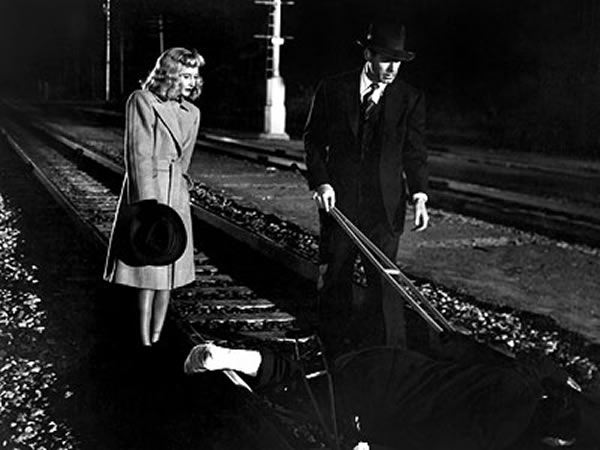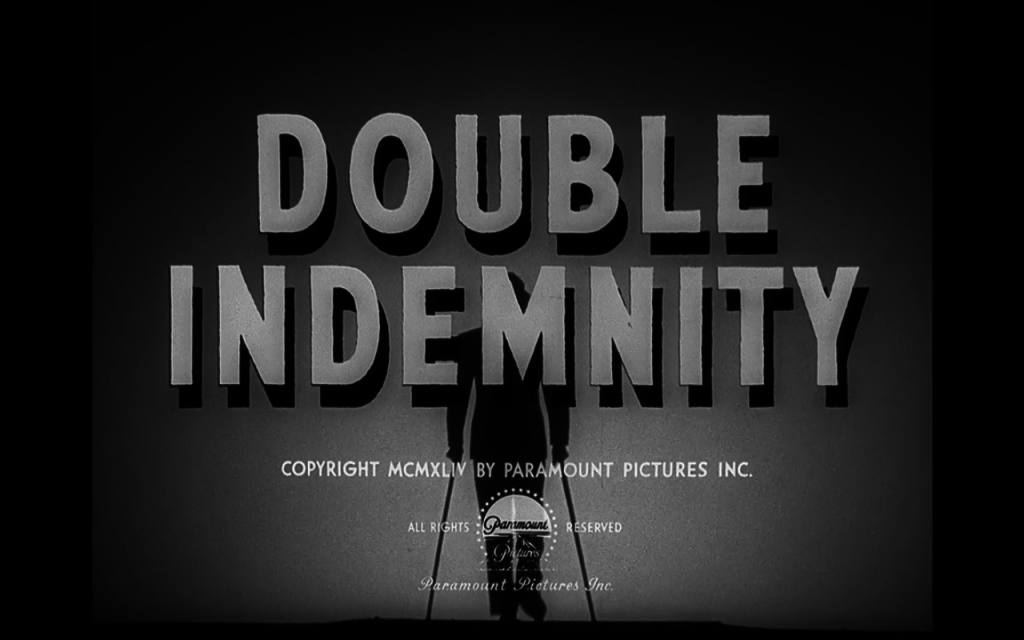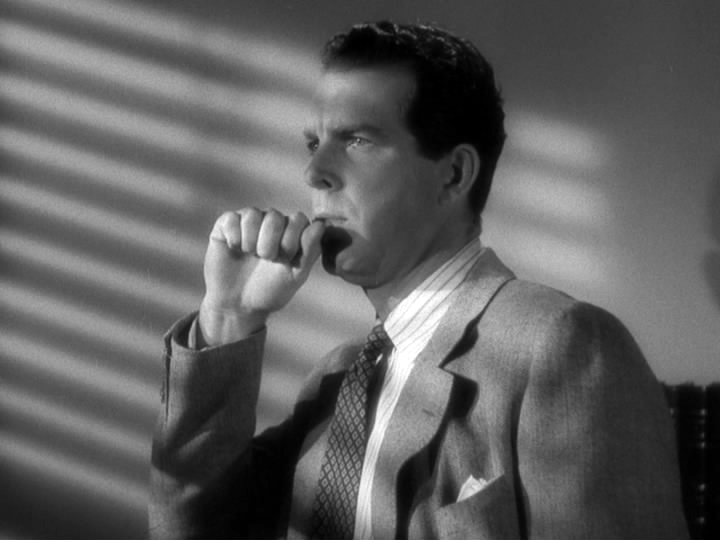A car careens through the dark streets of downtown L.A., avoiding an accident and blowing through a red signal. A man gets out of a car and enters an office building, getting curious looks and questions from the night attendant. He goes to his office, shaky and weak. He lights a cigarette in his trademark manner, striking the match with his thumbnail, then readies his Dictaphone. He speaks out a memo for his boss at the Pacific All Risk Insurance Co. “I suppose you’ll call this a confession,” he states. “Well I don’t like the word confession. I just want to set you right about something you couldn’t see because it was smack up against your nose.”
Set to the unforgettably dramatic and alternately mysterious musical score of Miklos Rozsa, thus opens Billy Wilder’s classic film noir – Double Indemnity. Like Wilder’s later Sunset Blvd. and typical of the film noir genre, the film starts at the end of the story, a device emphasizing the fatality of the characters’ lives. Also paired with the end-of-story beginning is a voice-over from the character explaining how things went wrong in their lives. With Fred MacMurray as Walter Neff, this comes early in his opening “confessional” scene regarding the Dietrichson case, the case that Edward G. Robinson as Barton Keyes finally suspects was murder. “Yes I killed him.” says Neff referring to Dietrichson. “I killed for money. And for a woman. I didn’t get the money and I didn’t get the woman.”
The woman was Barbara Stanwyck playing femme fatale Phyllis Dietrichson. Walter Neff was a sucker as soon as he saw her at the top of the stairs wearing a bath robe, and sealed when she sat down across him wearing an ankle bracelet. Their sharp repartee moves quickly from her anklet to auto insurance to accident insurance to a come-on that is deftly repelled, with a succession of double-entendres leading to a time for him to return when her husband will be there. And of course her husband wasn’t there when Neff returns, with Neff now ready to settle in. But her plan of taking out accident insurance on her husband without him knowing about it has Neff beating a quick retreat. But Neff can’t get her out of his mind, and all it takes is a visit from Phyllis to his apartment late at night to set things in motion.
This entry in the Classic Movie Blog Association’s Planes, Trains, and Automobiles Blogathon, features a central plot element aboard a train.
The story itself was ripped from the headlines, a case from 1927 when a wife and her boyfriend knocked off the husband for insurance money. The noted noir writer James M. Cain (The Postman Always Rings Twice) serialized his novella of “Double Indemnity” in Liberty Magazine before it was published as a book. A script outline had been sent to the Production Code Administration (the censors) by Louis B. Mayer as early as 1935, with the response that the story was “in violation of the Production Code,” with the same information given to Warner Brothers some years later. When Billy Wilder got interested in the story he asked Cain to write the script but he was too busy, so Wilder turned to Raymond Chandler who accepted. Wilder and Chandler did not get along. They were very much opposite personalities, and Chandler’s heavy drinking didn’t help. Chandler had written books but no scripts, so they stayed in the same room working on the script until the script was finished – and they couldn’t stand each other.They shared script-writing credits although Chandler’s characteristic clipped, hard-boiled dialogue is a hallmark of the film, along with his facility with the thinly veiled dialogue of sexual come-ons. A rare glimpse of Raymond Chandler seated on a bench reading a book can be seen as Fred MacMurray exits Edward G. Robinson’s office for the first time.

This was an early film noir and a trend-setter. It was Billy Wilder’s first great film, but at the time everybody turned down the roles of the criminal leads. Billy Wilder had to convince Barbara Stanwyck to take the part of the femme fatale Phyllis Dietrichson, her first unsympathetic role. Fred MacMurray, a former saxophone player, had previously only played in nice romantic comedy roles. Here he plays a devious insurance agent suckered into a murder scheme for money and for a woman. Edward G. Robinson was uninterested in playing a supporting role, having been a lead since the 1930s. As it turned out, these were all memorable career roles for the three actors. The scenes between Stanwyck and MacMurray were masterfully shot by cinematographer John Seitz, pushing the envelope of darkness in interior and exterior lighting, and using the coming noir trademark of Venetian blind shadowing to foreshadow the prison bars in Neff’s future.
And of course this is a story of pre-meditated murder. One of those where the premeditated part is supposed to be a plan where all the details are worked out so that the insurance money is collected and the murderers get away with the crime. The fatality of film noir is emphasized early in the plot, however, “The machinery had started and nothing could stop it,” said Neff. It’s Walter Neff’s voice-over we hear, his point of view, his slip from ordinary insurance salesman to punch-drunk lover to murderer. And yet his good-looks and soft-spot for the daughter Lola Dietrichson and her rough-edged boyfriend leads us to sympathize with his plight. As for Phyllis, she’s “rotten to the heart” as she admits, but achieves a sort of redemption by not following through with killing Neff, and gets killed instead. A repeated line in the script emphasized their partnership “straight down the line.” Neff’s boss Barton Keyes (Edward G. Robinson) said it more explicitly about the pair in the crime, “They’re stuck with each other. They have to ride all the way to the end of the line, it’s one-way and the last stop is the cemetery.”
The crime itself was a simple strangulation in an automobile, with the plan to dump the body next to the rail-road tracks and make it look like the body had fallen off the train. This would be made verifiable by Neff getting on the train earlier and mpersonating Mr. Dietrichson, complete with fake broken leg and crutches. Only there was another rider on the observation deck, who saw him, but he was sent of to fetch “Dietrichson’s” forgotten cigarettes. He could now jump off near where the body was, and be picked up by Phyllis and be dropped off near his apartment. It all seemed to work, except that when Neff was walking home, Neff reflected on his situation, “I felt that everything would go wrong. I couldn’t hear my own footsteps. It was the walk of a dead man.”

Those were haunting words and thoughts for the man who had planned it all to go perfectly. But was he really in control? Or was he a patsy in Phyllis’ scheme. Keyes is suspicious, and won’t pay on the claim; Lola visits Neff and they spend time together, where she says Phyllis was her mother’s nurse but believes she murdered her to marry her father; and then Neff hears Keyes’ Dictaphone recording of his suspicions, including private eye evidence that Phyllis and Lola’s ex-boyfriend Zachette were spending a lot of time together. Neff no longer trusts Phyllis, and believes he has to get off of that one-way train.

Neff calls Phyllis and sets up a meeting at her house. They had been holding secretive meetings at “Jerry’s Market” up until then. Phyllis is prepared, with a handgun tucked away under the cushion of her stuffed chair. Neff tells her he knows she’s been playing him for a sucker, that she was going to run off with the money, but now Keyes isn’t paying off on the insurance, and has Zachette down as the murderer, with her as the accomplice, and he was getting off this train. Then Phyllis shoots Neff, wounding him in the shoulder. “You can do better than that baby,” he says. As he walks toward her she holds the gun but doesn’t shoot. “Don’t tell me you loved me all this time.” “No, I never loved you, Walter, not you or anybody else. I’m rotten to the heart. I used you just as you said. That’s all you ever meant to me. Until a minute ago, when I couldn’t fire that second shot. I never thought that could happen to me.” “Sorry, baby I’m not buying.”
Phyllis has a look of surprise and horror when Neff shoots her, twice. Walter lay her down on the couch, dead. Once outside, Neff runs into Zachette, and tells him to call Lola, who really loves him, and to beat it. Neff then goes on a speed run to where we first saw him, making his confession. Only now, barely holding on as he speaks, Barton Keyes overhears him. Neff asks for time to get to the border, Keyes tells him he won’t make it to the elevator. Indeed, he collapses at the office doorway. Neff props himself up, as Keyes bends down beside him. “You know why you couldn’t figure this one Keyes? I’ll tell you. Cause the guy you were looking for was too close, right across the desk from you.” “Closer than that, Walter.” “I love you too.” Neff says.
Neff tries to light a cigarette. Keyes does it for him, striking the match with his thumbnail. With Rosza’s now indelible pounding theme music closing out the scene, Double Indemnity comes to its end. It was dialogue like that quoted above and the closing scene that distinguishes Double Indemnity and makes it sublime among Noir films. An alternate ending had Neff going to the gas chamber (in the book the lovers commit suicide). It tested unpopular and in reality would have compromised the greatness of the ending above.
The look of Barbara Stanwyck as Phyllis Dietrichson is very characteristic in the strict definition of the word. Her blond wig and dark glasses as worn in the last Jerry’s Market scene is often viewed as a clip from the movie. Billy Wilder himself selected the wig from a wig store, rather than to have the more professional studio hair stylist dye and prepare her hair. Some say it was to make Phyllis seem “cheap.” I think it was to emphasize the “costumed” character, playing one of her many roles: wife; seductress; nurse; step-mother; murderess; widow; spy. Edith Head designed her costumes. Barbara and Edith had developed a close relationship since working together on The Lady Eve, Ball of Fire and several other movies. In this period of the early and mid-1940s, Edith had developed a very flattering silhouette for Barbara, whose slight, long waisted figure was improved with Edith’s designs. Characteristic of the film and also of several films noir are the location shots. Here we see Jerry’s Market at 5330 Melrose Avenue, the “Dietrichson” house at 6301 Quebec Drive in the Hollywood Hills, 5th and Olive for the beginning car scene, 1825 N. Kingsley Drive for Walter Neff’s apartment, and the intersection of Hollywood and Western, among others.
Double Indemnity received seven Academy Award nominations, including Best Picture, Director, Actress, Writing, Music, Cinematography and Sound. It won in none of those categories. It received no Best Supporting Actor nomination, which continued Edward G. Robinson’s streak of never having won an Academy Award. The winner of Best Picture that year was Going My Way.
The American Film Institute ranks it #27 in the 10th edition of 100 Years 100 Movies.
Views: 610






Hi! Long time since I visited. Love this movie and have seen it often. The dialogue floors me, but that happens in many of Billy Wilder’s best films. MacMurray, Stanwyck, Robinson — a perfect cast, and that perfect ending. You captured it all so well. And I agree with your interpretation of the blonde wig and the roles Phyllis plays. Well done!
Happy to hear from you Classicfilmboy.Yes, it’s a real classic that like you I can watch over and over again. I love that dialogue too. I’ve read most all of the Raymond Chandler books and it’s in every one. People imitate him but they can never get it right so they end up just making it cynical. Thanks for your comments.
My mother introduced me to this movie when I was a teenager, and this movie introduced me to the notion that the telling of a story can be made into work of art.
EXCELLENT review. Like Caftan Woman, I’ve seen this film a zillion times, but you’ve brought a fresh perspective to it. I love how you wrote about that incredible ending – one of the best endings in classic film, in my opinion.
I agree with you about the ending Silver Screenings, it so resonates with the beginning, with the match-lighting, reversed. With the repetition of “I love you, too.” by Neff, only now it’s evident how much Keyes felt for him, and the tragic end is inevitable.
I love this movie! Wonderful post, and great addition to the blogathon!
It is such a treasure Cameron. I’m glad you enjoyed the post.
You really picked up the mood and tone of this classic of classics beautifully, Christian. You hit on all that is great about Double Indemnity, including Rozsa’s brilliant noir score. And the wig, which I’ve always hated but which works so well. Great review.
Thanks Lady Eve.I could have carried on about Rosza’s music, which I know you appreciate as well as musical scores in film. And the writing, where so much excellence comes out of conflict behind the scenes. It was an exciting film to blog about.
All because the car needed insurance. This film is just so perfect in every way (and maybe Eddie G is just a little more perfect than the rest).I’ve always had trouble with that wig, but your analysis makes me see that femme fatale in a new light. Excellent post,
Thanks FlickChick. I agree with you about the wig – it always looked so un-natural on Barbara Stanwyck, but that was the point. With her sunglasses it was like a mask.
And besides his acting as you point out, Edward G. served as the anchor in this film.
Excellent. This may sound strange since I’ve seen the film so many times, but reading your article I could feel the tension as if I’d just stumbled onto these characters for the first time.
I’m glad you got to relive the experience a little bit Patty, I think the dialogue and remembering that excellent acting will do that. I bet just hearing a few notes of the music would do it too. Thanks for your comments.